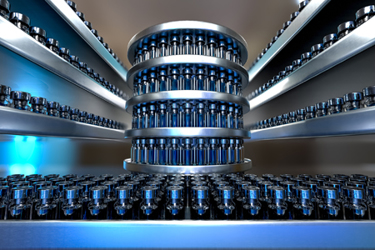CM2 + AI = Better Manufacturing At Your CDMOs

By Louis Garguilo, Chief Editor, Outsourced Pharma

This is the final in our series pursuing the practical use of artificial intelligence (AI) in the biopharma supply chain, guided by Professor Tinglong Dai of Johns Hopkins. (part one is here; part two here.)
Let’s enter midstream:
“We can learn a lot from non-pharmaceutical, non-health sectors,” says Dai.
He mentions Amazon, “a company that for years has faced the problem of detecting damaged packages before they are shipped.”

But a simple AI application for image detection does work.
Images or video of the “status of the boxes” is continuously analyzed by AI software for shapes, taping, closures, dents or other anomalies that you preset and have compared to a “normal package."
“Any company can implement this capability now,” Dai stresses, and can do so without hiring a cadre of AI technicians or developers. He adds that “readily available, no-code or low-code AI training tools are of great help.”
My question, then:
Are there companies today offering off-the-shelf, AI-software products specifically for biopharma manufacturing adaptation, and our highly regulated supply chains?
“Using our example above,” replies Dai, “you can purchase commercial object-detection packages, but you will need some development and customization work to make them helpful for specific industrial applications like a pharma setting.”
As readers may have experienced, it's that customization work which puts a pause in the minds of executives – at both CDMOs and drug sponsors – responsible for budgets (and timelines).
Dai has a different take. He believes this “requirement” is actually a key to opening a world of possibilities with AI and machine learning in the biopharma industry.
“It’s important to take part in your AI development process,” he says.
“Get involved in deciding what exactly you want captured and analyzed to remedy specific challenges. Then create a process for testing a phased integrating into your product and workflow monitoring and analysis.”
You decide what you want AI to tell you. And it is easier than many have suggested.
Request AI At CDMOs
Consider this:
A fill-and-finish provider offers you AI/ML (machine learning) applications continuously monitoring and effectively reducing a variety of production challenges. Quality is improved. The technologies and the CDMO's operators team up for further improvements. Those operators also involve you the customer as well.
A second fill-and-finish service provider has little or none of the above to offer. Sooner rather than later, which CDMO you select may significantly hinge on that discrepancy.
With the first CDMO, you might request that the additive software inform your provider of key parameters to look for as your scale-ups are cursing through a continuous manufacturing process for the first time.
When sponsors start to better understand what AI can do for them, they can take full advantage of advanced monitoring and predictive analysis. This in turn will propel CDMOs to think more seriously and expansively about how they can better operate their facilities overall.
Dai readily admits there are initial challenges to implementing and fine-tuning in the tools for AI/ML support, but iterates those challenges "are ultimately rewarding."
"Along the way, you learn how to save money, and make the manufacturing process and your entire supply chain safer and more reliable.”
In a recent Wall Street Journal interview, when asked how we can ensure CDMOs manufacturing our drugs are doing so safely, Dai mentioned AI-enhanced motion, sound, and image detection are keys, with an important caveat:
“We do need some sort of a continuous monitoring system.” He added: “Whatever it is that the manufacturer is monitoring, it has to be continuous.”
“The fact that a manufacturing processes is being monitored makes it safer even if you aren’t performing AI algorithms of any kind. Being monitored will make facilities safer.”
Add AI/ML and you gain a higher power of prediction, earlier warnings of anamolies, and, says Dai, "enhanced training for implementing better procedures."
The ultimate goal is to elevate the state of development and processing throughout the biopharma ecosystem.
Continuous manufacturing with continuous monitoring is how our goals are achieved.
CM2 + AI = Advancement
Let’s call it CM2 – continuous manufacturing and continuous monitoring – with AI/ML turbocharging predictability, learning, safety, and productivity.
This is our manufacturing future. It could be our manufacturing present.
From what Dai has observed to date, continuous manufacturing is not yet moving steadily through the U.S. ecosystem, but is in countries such as Australia, New Zealand, parts of Asia (but not, interestingly, in China or India), and Western European countries like Germany and Italy.
Will CDMOs there gain advantages with global sponsors?
“They know this technology best – practically speaking, I mean early detection – works, and CM and AI/ML provide more insights than current testing regiments at intervals,” says Dai.
CM2 + AI would at the least provide insights into quality control and safety standards, “but for whatever reason,” laments Dai, “I think the U.S. is behind.”
Regarding CDMOs specifically, where much of the new technology will need to reside, Dai says there’s evidence they are hiring more professionals who understand, for example, data science and optimization.
“I’m not talking so much about hiring AI developers,” he clarifies, “although I do know quite a few professionals who are working with Big Pharma companies who have substantial AI teams.”
“They will be involved with deeper learning, making sense of unstructured data – images, videos, audio, or any patterns that you cannot put in an Excel file to gain understanding from,” Dai says. (see part two)
“Practically speaking, that's really what I mean today by AI in biopharma. The entire industry will always be data intensive. There’s a tremendous amount of statistical or data science expertise already, no question about that.
"I fully understand AI is a new game, but I know a lot of people working with these companies who are expanding that expertise.
“Are they going about things correctly? I think they are. Mostly today, though, it is still on a pilot basis. They are experimenting. I’m not sure they are yet accelerating into broader processing solutions.”
Let's hope that happens soon. Dai says the tools are there. We'll keep monitoring.
